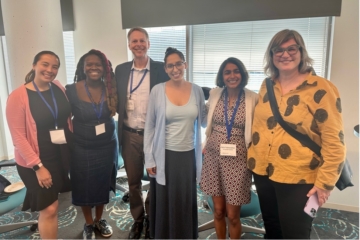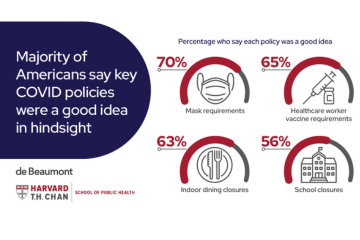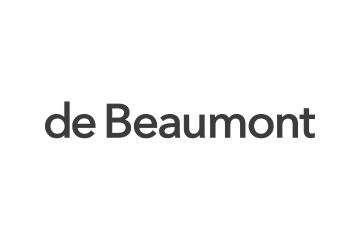
Photo of Dr. Gollust teaching. Photo courtesy of the University of Minnesota School of Public Health
One in six. One in six respondents to the 2021 Public Health Workforce Interests and Needs Survey (PH WINS) agreed or strongly agreed that they had felt bullied, threatened, or harassed by individuals outside of the health department because of their role as a public health professional. This number is larger for employees age 21-30 as well as those with an MPH degree. Trying to make sense of these numbers, I considered the volume of MPH students I have taught over the past 12 years, and how they have a higher-than-average rate of workplace harassment.
One of my courses, Ethics in Public Health Practice, is a core class required of all MPH students at my institution, the University of Minnesota School of Public Health. I have taught this course 24 times since 2011 – in-person, fully online, and in Zoom-enabled formats I’d rather forget. With an average of 25 students per section, I have engaged with more than 600 future public health professionals about the ethical and moral issues that animate and constrain our field. The course reinforces the idea that public health workers must be able to articulate the ethical principles that support their work, and that transparently communicating those justifications can help build the public’s trust. The PH WINS data demonstrating such high levels of public animosity toward public health workers challenges this very premise.
One in six.
This means that at least 100 of my former students would have experienced this mistreatment, with grave consequences for their emotional well-being. These data are not only personally heartbreaking, but contribute to three reflections about my role as a public health educator and advocate for a strengthened public health field.
All of us who care about public health must advocate to support the workforce.
As I have written elsewhere, the public’s rising perception that threatening or bullying public health workers is permissible is a grave concern. To counter it, we must advocate for mental health support for the public health workforce and simultaneously demand that our political leaders visibly and consistently support the workforce and denounce violent threats.
I worry about the chilling effect of these data on current and future students.
Already, only 14% of the public health workforce has a public health degree. My own MPH students who completed internships and applied experiences with health departments during 2020-2022 saw first-hand the palpable burnout, exhaustion, and stressors their colleagues and supervisors experienced. In order to support retention efforts, public health educators need to personally re-commit to strengthening their own relationships with local and state public health workers to learn more about the humans behind these data. We must enrich our courses with the real world of public health practice – finding and sharing with our students the “mutual inspiration, the sense of fulfillment, and the creativity associated with talented and dedicated colleagues”, as Dr. Chokshi so elegantly put it, the necessary counterweight to the data revealing trauma and pain. Only through building our own relationships and illuminating the bright spots of the dedicated workforce can we encourage our most talented and creative students to pursue careers in governmental public health.
The next generation of public health workers are more committed to anti-racism and health equity than previous ones.
In my teaching career to date, I have never seen my students as committed to anti-racist action and centering health equity in their work as they have been in the last three years. I was not surprised to see in the PH WINS data that awareness of these concepts was highest among members of the workforce with public health degrees. Translating this awareness and eagerness into action is critical both for authentic movement on improving population health and for providing the public health workforce with meaning to sustain them in the hard work ahead. Programs like the STRETCH initiative (Strategies to Repair Equity and Transform Community Health) which support the health equity and community engagement actions of state health departments are sorely needed. So too are communication strategies to help the workforce talk about public health and health equity goals in terms that the general public can understand and support. Educators and public health leaders must capitalize on the enthusiasm to address health equity by giving these often-younger visionaries the tangible support they need to truly center health equity in practice, while sheltering them from political threats.
While many of the articles in the Journal of Public Health Management and Practice supplement are disheartening, I also see reasons for optimism—namely, that these data, along with advocacy and centering the stories of workers, could provide the needed justification for change. The data highlight the challenges the workforce faced and continues to face, and also provide a call to action: the articles demand that we see the people – not just the data points – who make up the public health workforce, and on whose resilience – and thriving – we all depend.
Sarah Gollust, PhD, Division of Health Policy and Management, University of Minnesota School of Public Health




